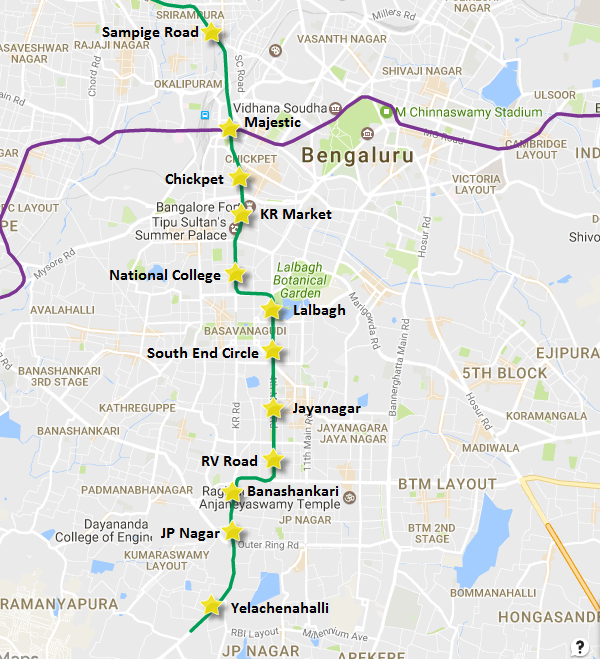[Pics] CMRS Visits Bangalore Metro’s Yelachenahalli Station
Yesterday afternoon, KA Manoharan, the designated Commissioner of Metro Rail Safety (CMRS) from the Indian Railways’ Southern Circle made a pre-inspection visit to Bangalore Metro’s Yelachenahalli (erst. Puttenahalli) Station – the southern terminal of the 24.20 km Green Line. During the brief three hour visit, he and his deputy observed the station’s equipment, electrical and controller’s rooms to check its launch-readiness.
The CMRS has other railway inspections lined up during the rest of the week in north Karnataka, and will be back in the city to conduct the final round of safety inspections on the 12 km Sampige Road – Yelachenahalli section between May 29-31 (Mon-Wed).
Here’s a brief agenda of the planned inspection:
• May 29 – Inspection of Yelachenahalli – National College (8 kms, Reach 4 & 4A)
• May 30 – Inspection of Sampige Road – National College (4 kms, UG 1)
• May 31 – Speed trial & Peenya Depot’s inspection
A highly detailed hourly programme for all 3 days can be viewed here.

Pending 12 km section of the Green Line – view Bangalore Metro map & information
Some images via BMRCL’s website:

Concourse level – Photo Copyright: BMRCL

Electrical room – Photo Copyright: BMRCL

Station controller’s room – Photo Copyright: BMRCL

And that’s a wrap! – Photo Copyright: BMRCL
Before you leave, check out this video of a Loram track-maintenance locomotive grinding the elevated Reach 4 section’s tracks.
For more updates, check out the Bangalore section of The Metro Rail Guy!
– TMRG



It’s a little surprising, the CMRS inspection, considering that they started testing in underground section only in April, and till March end, they hadn’t even finished Electrical works on Northbound line between Majestic and Mantri Square Stations, isn’t it? Doesn’t it usually take three-four months for all the trials to finish?
I’ve had similar thoughts. While it is possible that BMRCL/Contractors worked double to complete the works, will they be 100% reliable? The metro connectivity is very important and earlier launch is required but never at the cost of safety. Hope this was kept in mind.
At the same time these inspections needs to be conducted during the rainy season to check for the water leakages or flooding, Tunnel Ventilation System, Annex’s if any as escape routes, Blue Light System, Fire Protection System, Fire Alarm System etc., as a safety measure. Before it can be approved these applies to any projects.
Good to see the progress – after a painfully slow progress.
@BMRCL (and anyone who knows and can answer),
I’ve 2 questions that are not specific to Namma metro.
1) What is typical life span of a Metro Viaduct (I understand structure and geology are important but a broad range would be good. and for structure Namma metro’s Viaducts can be examples 🙂 )?
2) How does it compare to the underground tunnels? E.g. there are metro tunnels in Paris that are very old and do not seem to be posing danger.
I would think viaducts & tunnels can last very, very long. The viaducts/tunnels in New York, London, Berlin, Chicago are very old, like in Paris. Inspections & maintenance are routinely done for those in use. Some of the old tunnels & stations in London & New York have been abandonned as they were unsuitable when rail networks got upgraded, but they are still surviving despite the long efflux of time. There is also a large network of abandonned unused tunnels in Cincinnati.
So, we can expect our viaducts & tunnels to last very long!
Any Projects one of the challenging issues facing is achieving a 100-year design life for the concrete structures under severe environmental conditions.
@SHAM, Thanks for your reply.
Very Long. Great! But how long is the question nagging me. I somehow feel that UG tunnels have better life than viaducts. Just wanted to see if there’s an approximate comparison of lifetimes etc. is possible. Any pointers?
@ TMRG What do you think?
Hi TMRG
Is BMRCL planning to open another depot for green line at the last stop this line in phase2?
Why do we need 2 depots for 1 line then.
Peenya depot will not have sufficient space for stabling all rakes. Hence another depot is being developed at Anjanapura for stabling.
Hi TMRG
I saw one news report and it says BMRCL is planning 12 TBM for phase 2 ( the shivaji nagar line ) . Do we really have that much space to make huge pits for 12 TBM . I think each TBM will need 200-300 meters long
pits and. at-least 100 meters wide too.
There are 12 stations in the underground stations and including the ramps, the TBM’s need to do minimum a of 13 breakthroughs in each line. For both the up and down lines it would be 26 breakthroughs. It would be roughly 2kms and 2 breakthroughs per TBM. Considering a moderate boring speed of 2-3m per day, it would take 2-3 years just for the tunnel boring. Assembly and disassembly of the TBMs would take some more time. So 12 TBMs is justified.
Coming to the space for TBM, they will be launched from shaft’s built inside the stations boxes. So much space has to be dug up for the building the stations. Might as well put a TBM to start from each station.